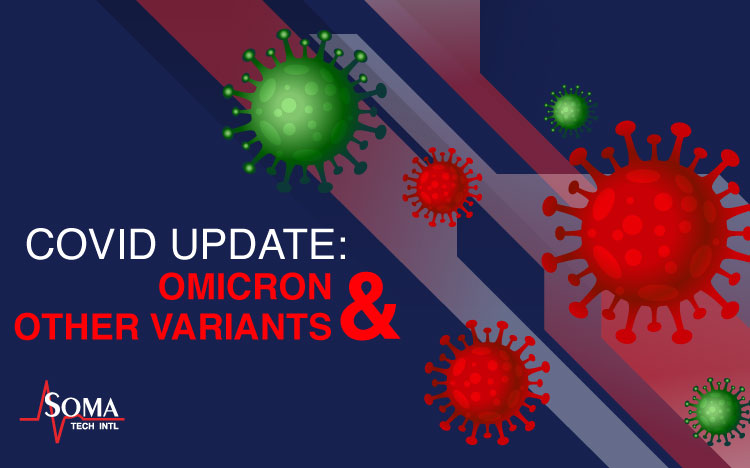COVID Update: The Increasing Cases of Omicron And Other Covid Variants
January 19, 2022
- What Are The COVID-19 Variants?
- How Long Is COVID-19 Contagious?
- What Are the Symptoms Of the Omicron Variant?
- Current Vaccinations
- How To Prevent Infection And Slow Transmission
- Final Thought
Before the start of the year, there had been a rampant increase in COVID-19 cases throughout the United States and other countries. As scientists learn what makes the Omicron different from other versions of the SARS-CoV-2 virus, guidance about how to deal with the COVID variant is changing fast.
In the U.S., where Omicron is now the dominant variant, the CDC (The Center for Disease Control and Prevention) has come under fire for its shifting guidelines, including a recently updated recommendation that halves the isolation period for people who test positive from 10 days to five. What is the science behind the changing guidance, and how can people best protect themselves as Omicron and emerging variants spread?
Continue reading to learn more.
WHAT ARE THE COVID-19 VARIANTS?
Viruses are always mutating which can cause a new variant of the virus to form. Although new variants are an expected part of the evolution of viruses, monitoring each one that surfaces is essential in ensuring we—in the U.S. and globally—are prepared. This is particularly true if a new COVID variant is more aggressive and highly transmissible compared to the original strain of the virus. Scientists monitor all variants but may classify certain ones as variants being monitored, variants of interest, variants of concern, and variants of high consequences. The primary variants of concern are:
Delta: First identified in December 2020 in India. The variant was first detected in the United States in March 2021.
Omicron: The variant was first detected in South Africa in November 2021, which caused a surge in new COVID-19 cases. The Omicron variant has a larger number of mutations and is more transmissible than Delta; making it the dominant variant in the U.S.
Additional variants like the Alpha, Gamma, and Beta variants continue to be monitored but are spreading at much lower levels in the U.S. The Deltacron—recently making headlines—is also being monitored as scientists gather further information.
HOW LONG IS COVID-19 CONTAGIOUS?
A person with COVID-19 is thought to be most contagious in the days immediately leading up to the first several days of his or her symptoms. However, it can take several more days for a person’s immune system to clear the virus from the body. A person with COVID-19 is likely no longer contagious after 10—14 days have passed since testing positive for coronavirus.
When it comes to staying home long enough to ensure you’re no longer contagious, be sure to follow the CDC’s isolation guidelines. Completing your isolation, even if you’re asymptomatic or your symptoms are clearing up and feeling better, is important to ensure you do not spread COVID-19 to others.
WHAT ARE THE SYMPTOMS OF THE OMICRON VARIANT?
All of the variants, including the Omicron and Delta, cause similar symptoms. The main symptoms include:
- Fever
- Coughing
- Trouble breathing
- Fatigue
- Chills, sometimes with shaking
- Body aches
- Headache
- Sore throat
- Congestion and runny nose
- Loss of smell or taste
- Nausea
- Diarrhea
Additionally, the virus can lead to pneumonia, respiratory failure, heart problems, liver problems, and even septic shock. A condition known as cytokine release syndrome may cause many COVID-19 complications. This is when an infection triggers your immune system to flood your bloodstream with inflammatory proteins called cytokines which can kill tissue and damage your organs.
CURRENT VACCINATIONS
The three COVID-19 vaccines that are authorized and approved for use in the U.S. to prevent COVID-19 variant infections are:
- Pfizer-Bio-NTech
- Moderna
- Johnson & Johnson’s Janssen
HOW TO PREVENT INFECTION AND SLOW TRANSMISSION
- To prevent infection and slow transmission of COVID-19, you should do the following:
- Make sure you take the full vaccines, including the booster shot.
- Stay at least 1 meter apart from others in public spaces.
- Wear a properly fitted mask when physical distancing is not possible or in poorly ventilated settings.
- Wash your hands regularly with soap and water or clean them with alcohol-based hand rub/sanitizers.
Cover your mouth and nose when coughing or sneezing. - If you feel unwell, stay home and self-isolate until you recover. Make sure to take a COVID test to ensure whether or not you have been exposed. There are also COVID self-test kits available at your nearest pharmacy and clinic.
FINAL THOUGHT
As Americans push into the third winter of viral discontent, this season has delivered something different: Amid the deep polarization about masks and vaccines, amid the discord over whether and how to return to pre-pandemic life, a strange unity of confusion is emerging. There has been a common inability to decipher conflicting guidelines. However, one thing is certain, everyone needs to acquire the recommended vaccinations and follow the safety guidelines everywhere we go. Getting a vaccine against any COVID variant is a key part of prevention.
If you are experiencing any symptoms or come into contact with someone who has been exposed to COVID-19, make sure to get tested. Even if you are fully vaccinated, it is important for you and those around you to take the proper precautions.
Have you or your loved ones been exposed to a COVID-19 variant? Have you taken your vaccines yet? What are your thoughts about this pandemic and how things are going? Please feel free to share your comments below!
Explore Other Blog Items By Category
Recent Posts


Surgical Microscope Rentals

